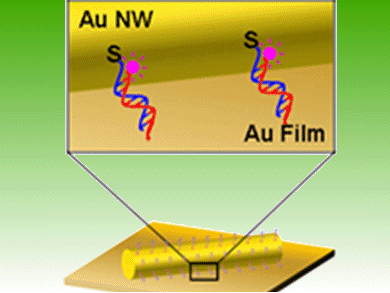There’s something in the water — Aquatically-derived food supplies often contain the water-soluble mercuric ion (Hg2+), which is toxic to humans.
Kim et al, KAIST, Korea, report an ultrasensitive and selective single gold nanowire-on-film (SNOF) surface-enhanced resonance Raman scattering sensor (SERS) for Hg2+ detection. The sensor is based on structure-switching double stranded DNAs; when Hg2+ is bound, a conformational change occurs enabling a Raman reporter to get close to the single gold nanowire-on film structure and turn on the signal.
The SNOF sensor has a detection limit of 100 pM, about 50 times lower than previously reported nucleic-acid-based Hg2+ SERS sensors. The sensor also exhibited good reproducibility, high selectivity, long-term stability, and reusability.
Development of a multiplex sensor of various ions may also be possible by combining nanowires modified by multiple types of nucleic-acid-binding macromolecules.

Image: (c) Wiley-VCH
- Au Nanowire-on-Film SERRS Sensor for Ultrasensitive Hg2+ detection
T. Kang, S. M. Yoo, I. Yoon, S. Lee, J. Choo, S. Y. Lee and B. Kim
Chem. Eur. J. 2011.
DOI: 10.1002/chem.201001663



detection by using FIA